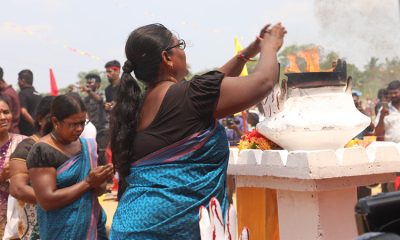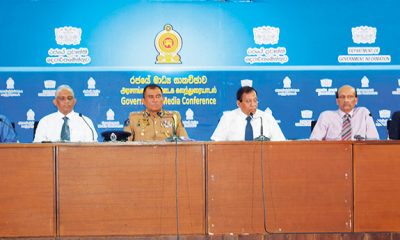Opinion
Instead of recreating conditions for protest …

By Jehan Perera
The stock market boomed after the much-awaited domestic debt restructuring programme (DDR), but the national economy continues to be in deep trouble. It does not seem to have the productive capacity and the general population does not have the purchasing power to lift itself out of the doldrums. Even those at the top end of the production chain, the owners of factories, are lamenting the lack of consumer demand for their goods and services. People do not have the money to purchase their output. Examples are given of three lorries per day leaving the factory whereas 60 went out prior to the economic collapse. Or of factories that have laid off 50 of their 200 employees. The newspaper delivery man said that the sale of the state-owned newspapers by him has slumped. He explained that offices used to buy them and said 15 of the 18 offices he distributed them to, in the neigbourhood, had closed.
The government is doing its best to meet international requirements for economic revival. The international community can make the difference in terms of a major inflow of resources that can kick-start the economy. The IMF’s approval is the international standard from which other possible international economic partners get their assurance. By engaging in the DDR process, Sri Lanka has begun the arduous journey of meeting the IMF-set economic targets. The IMF sets the targets for economic sustainability, be it by increasing tax revenue or decreasing the budget deficit by a recommended percentage. It is the Sri Lankan government that is expected to decide how it will meet those targets. The government has chosen a path that attempts to deflect the costs away from the corporate sector and its supporters without an attempt being made to recover stolen assets.
One of the main casualties of the restructuring process is the social welfare programme that successive governments sustained over the previous decades. Aswesuma seeks to provide benefits to two million poor and vulnerable families. LIRNEasia’s national survey has shown that four million individuals have fallen into poverty since 2019, and that seven million people are living in poverty at present. It can be anticipated, therefore, that the selection process will and has caused enormous strife, as there is dispute at the local level about who should be a beneficiary and who should not. Another major casualty has been the EPF/ETF pensions. The taxing of the pension funds and the reduction in the interest they will receive is causing less pain at the present time, but it will surely cause pain later on when those who retire find that the money they receive does not go very far.
VOLATILE SITUATION
President Ranil Wickremesinghe’s achievement is that he has been able to lead a government that is composed of ruling party members who were and possibly remain his political opponents. He is getting them to pass laws that will lead to economic restructuring that is causing pain to the majority of people. Opposition and SJB leader Sajith Premadasa has pointed out that the EPF pension fund would lose as much as 12 trillion rupees (USD39 billion) by 2038. Citing a report by economic think tank Verite Research, he said “When the heads of the EPF and the ETF were questioned by the Public Finance Committee it was found that this government had not consulted them before introducing the DDO plan. No government body has assessed the losses to be borne by the workers. The Verite Research in its assessment says that the amount would be more than 12 trillion rupees.”
The ruling party members would be aware of the economic discontent among the masses of people who cannot make ends meet. Public opinion polls show that the government, and the President in particular, are gaining in popularity, but it also shows that the overall popularity level continues to be low. The approval rating of the government doubled to 21 percent in June 2023 from the 10 percent that was recorded in both February 2023 and October 2022, according to the latest round of the Gallup style ‘Mood of the Nation’ poll of Verité Research. This may explain the government’s determination not to conduct the local government elections that are now four months overdue and to postpone elections infefintely. These are disturbing signs of a movement towards unsustainable autocracy if the provincial elections are not held any longer and if the local polls are also postponed indefinitely.
In these circumstances, the polarization between the government and Opposition is likely to grow. The government is passing new laws and seeking to pass controversial ones, such as resurrecting the local government authorities in lieu of holding fresh elections, restricting media freedom and expanding the scope of anti-terrorist laws, using its majority in Parliament. However, this majority was elected in a different time before the collapse of the economy. Now that the government’s popularity is only at the 20 percent level it can be seen that the masses of people will not be supportive of what the government is doing. This creates a potentially volatile situation in a country that has been long accustomed to changing unpopular governments at elections. It is not reasonable to expect the people to remain patient forever, it could well lead to another Aragalaya.
REQUIRED COOPERATION
The prevailing situation in France is a warning of what can happen in Sri Lanka unless economic hardships facing the people are speedily mitigated. France has been experiencing a wave of riots and looting since a police officer shot and killed a 17-year-old boy, of Algerian origin, during a traffic stop. The incident sparked outrage and protests among people who accused the police of racism and brutality. The unrest soon spread to other cities across the country, including Paris, where rioters clashed with the police, set fire to cars and buildings, and ransacked shops and businesses. More than 3,000 people have been arrested so far, and the damage is estimated at over USD 1 billion. Many of the rioters are young people who feel marginalized and hopeless in a country where the police are accused of using excessive force and targeting minorities.
The problem in Sri Lanka at the present time is that the government does not have the economic resources to distribute as social welfare to mitigate the economic dislocations caused by job losses and the fallen value of the rupee. The World Bank estimates are that the national economy, which shrank by more than seven percent last year, will continue its downward spiral by a further fall of three percent this year. The resurrection of more than 8000 local government councillors from dissolved local authorities in lieu of elections, as proposed by the government, will be outrageous to people who have lost their jobs and are teetering on the brink of economic survival. It will be a reminder of the Aragalaya’s uncompleted mission of sending the rogues home and effecting a system change.
At a recent public event, President Ranil Wickremesinghe emphasized the importance of avoiding misleading arguments and instead urged the entire opposition, led by the Opposition leader, to join the government in addressing the country’s challenges. There is one area in which the Opposition can and must support the President and that is in resolving the ethnic conflict and reaching the goal of national reconciliation. Such a success will have the potential to mobilise international support on a large scale. The President has demonstrated commendable courage and vision in this area. Resolving this problem will unify the country and translate into renewed international confidence in Sri Lanka’s future and the economic investments that can flow in as a result. Victory will surely come when we say we did it together.
Opinion
The policy of Sinhala Only and downgrading of English
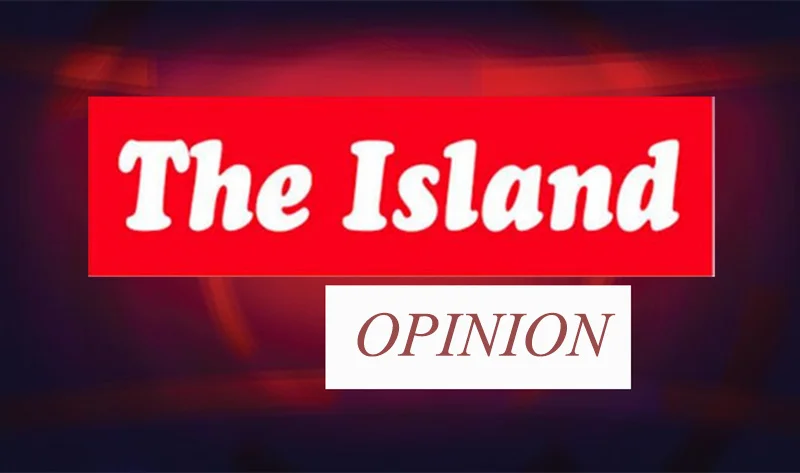
In 1956 a Sri Lankan politician riding a great surge of populism, made a move that, at a stroke, disabled a functioning civil society operating in the English language medium in Sri Lanka. He had thrown the baby out with the bathwater.
It was done to huge, ecstatic public joy and applause at the time but in truth, this action had serious ramifications for the country, the effects have, no doubt, been endlessly mulled over ever since.
However, there is one effect/ aspect that cannot be easily dismissed – the use of legal English of an exact technical quality used for dispensing Jurisprudence (certainty and rational thought). These court certified decisions engendered confidence in law, investment and business not only here but most importantly, among the international business community.
Well qualified, rational men, Judges, thought rationally and impartially through all the aspects of a case in Law brought before them. They were expert in the use of this specialised English, with all its meanings and technicalities – but now, a type of concise English hardly understandable to the casual layman who may casually look through some court proceedings of yesteryear.
They made clear and precise rulings on matters of Sri Lankan Law. These were guiding principles for administrative practice. This body of case law knowledge has been built up over the years before Independence. This was in fact, something extremely valuable for business and everyday life. It brought confidence and trust – essential for conducting business.
English had been developed into a precise tool for analysing and understanding a problem, a matter, or a transaction. Words can have specific meanings, they were not, merely, the play- thing of those producing “fake news”. English words as used at that time, had meaning – they carried weight and meaning – the weight of the law!
Now many progressive countries around the world are embracing English for good economic and cultural reasons, but in complete contrast little Sri Lanka has gone into reverse!
A minority of the Sinhalese population, (the educated ones!) could immediately see at the time the problems that could arise by this move to down-grade English including its high-quality legal determinations. Unfortunately, seemingly, with the downgrading of English came a downgrading of the quality of inter- personal transactions.
A second failure was the failure to improve the “have nots” of the villagers by education. Knowledge and information can be considered a universal right. Leonard Woolf’s book “A village in the Jungle” makes use of this difference in education to prove a point. It makes infinitely good politics to reduce this education gap by education policies that rectify this important disadvantage normal people of Sri Lanka have.
But the yearning of educators to upgrade the education system as a whole, still remains a distant goal. Advanced English spoken language is encouraged individually but not at a state level. It has become an orphaned child. It is the elites that can read the standard classics such as Treasure Island or Sherlock Holmes and enjoy them.
But, perhaps now, with the country in the doldrums, more people will come to reflect on these failures of foresight and policy implementation. Isn’t the doldrums all the proof you need?
by Priyantha Hettige
Opinion
GOODBYE, DEAR SIR

It is with deep gratitude and profound sorrow that we remember Mr. K. L. F. Wijedasa, remarkable athletics coach whose influence reached far beyond the track. He passed away on November 4, exactly six months after his 93rd birthday, having led an exemplary and disciplined life that enabled him to enjoy such a long and meaningful innings. To those he trained, he was not only a masterful coach but a mentor, a friend, a steady father figure, and an enduring source of inspiration. His wisdom, kindness, and unwavering belief in every young athlete shaped countless lives, leaving a legacy that will continue to echo in the hearts of all who were fortunate enough to be guided by him.
I was privileged to be one of the many athletes who trained under his watchful eye from the time Mr. Wijedasa began his close association with Royal College in 1974. He was largely responsible for the golden era of athletics at Royal College from 1973 to 1980. In all but one of those years, Royal swept the board at all the leading Track & Field Championships — from the Senior and Junior Tarbat Shields to the Daily News Trophy Relay Carnival. Not only did the school dominate competitions, but it also produced star-class athletes such as sprinter Royce Koelmeyer; sprint and long & triple jump champions Godfrey Fernando and Ravi Waidyalankara; high jumper and pole vaulter Cletus Dep; Olympic 400m runner Chrisantha Ferdinando; sprinters Roshan Fernando and the Indraratne twins, Asela and Athula; and record-breaking high jumper Dr. Dharshana Wijegunasinghe, to name just a few.
Royal had won the Senior & Junior Tarbats as well as the Relay Carnival in 1973 by a whisker and was looking for a top-class coach to mould an exceptionally talented group of athletes for 1974 and beyond. This was when Mr. Wijedasa entered the scene, beginning a lifelong relationship with the athletes of Royal College from 1974 to 1987. He received excellent support from the then Principal, late Mr. L. D. H. Pieris; Vice Principal, late Mr. E. C. Gunesekera; and Masters-in-Charge Mr. Dharmasena, Mr. M. D. R. Senanayake, and Mr. V. A. B. Samarakone, with whom he maintained a strong and respectful rapport throughout his tenure.
An old boy of several schools — beginning at Kandegoda Sinhala Mixed School in his hometown, moving on to Dharmasoka Vidyalaya, Ambalangoda, Moratu Vidyalaya, and finally Ananda College — he excelled in both sports and studies. He later graduated in Geography, from the University of Peradeniya. During his undergraduate days, he distinguished himself as a sprinter, establishing a new National Record in the 100 metres in 1955. Beyond academics and sports, Mr. Wijedasa also demonstrated remarkable talent in drama.
Though proudly an Anandian, he became equally a Royalist through his deep association with Royal’s athletics from the 1970s. So strong was this bond that he eventually admitted his only son, Duminda, to Royal College. The hallmark of Mr. Wijedasa was his tireless dedication and immense patience as a mentor. Endurance and power training were among his strengths —disciplines that stood many of us in good stead long after we left school.
More than champions on the track, it is the individuals we became in later life that bear true testimony to his loving guidance. Such was his simplicity and warmth that we could visit him and his beloved wife, Ransiri, without appointment. Even long after our school days, we remained in close touch. Those living overseas never failed to visit him whenever they returned to Sri Lanka. These visits were filled with fond reminiscences of our sporting days, discussions on world affairs, and joyful moments of singing old Sinhala songs that he treasured.
It was only fitting, therefore, that on his last birthday on May 4 this year, the Old Royalists’ Athletic Club (ORAC) honoured him with a biography highlighting his immense contribution to athletics at Royal. I was deeply privileged to co-author this book together with Asoka Rodrigo, another old boy of the school.
Royal, however, was not the first school he coached. After joining the tutorial staff of his alma mater following graduation, he naturally coached Ananda College before moving on to Holy Family Convent, Bambalapitiya — where he first met the “love of his life,” Ransiri, a gifted and versatile sportswoman. She was not only a national champion in athletics but also a top netballer and basketball player in the 1960s. After his long and illustrious stint at Royal College, he went on to coach at schools such as Visakha Vidyalaya and Belvoir International.
The school arena was not his only forte. Mr. Wijedasa also produced several top national athletes, including D. K. Podimahattaya, Vijitha Wijesekera, Lionel Karunasena, Ransiri Serasinghe, Kosala Sahabandu, Gregory de Silva, Sunil Gunawardena, Prasad Perera, K. G. Badra, Surangani de Silva, Nandika de Silva, Chrisantha Ferdinando, Tamara Padmini, and Anula Costa. Apart from coaching, he was an efficient administrator as Director of Physical Education at the University of Colombo and held several senior positions in national sporting bodies. He served as President of the Amateur Athletic Association of Sri Lanka in 1994 and was also a founder and later President of the Ceylonese Track & Field Club. He served with distinction as a national selector, starter, judge, and highly qualified timekeeper.
The crowning joy of his life was seeing his legacy continue through his children and grandchildren. His son, Duminda, was a prominent athlete at Royal and later a National Squash player in the 1990s. In his later years, Mr. Wijedasa took great pride in seeing his granddaughter, Tejani, become a reputed throwing champion at Bishop’s College, where she currently serves as Games Captain. Her younger brother, too, is a promising athlete.
He is survived by his beloved wife, Ransiri, with whom he shared 57 years of a happy and devoted marriage, and by their two children, Duminda and Puranya. Duminda, married to Debbie, resides in Brisbane, Australia, with their two daughters, Deandra and Tennille. Puranya, married to Ruvindu, is blessed with three children — Madhuke, Tejani, and Dharishta.
Though he has left this world, the values he instilled, the lives he shaped, and the spirit he ignited on countless tracks and fields will live on forever — etched in the hearts of generations who were privileged to call him Sir (Coach).
NIRAJ DE MEL, Athletics Captain of Royal College 1976
Deputy Chairman, Old Royalists’ Athletics Club (ORAC)
Opinion
Why Sri Lanka needs a National Budget Performance and Evaluation Office

Sri Lanka is now grappling with the aftermath of the one of the gravest natural disasters in recent memory, as Cyclone Ditwah and the associated weather system continue to bring relentless rain, flash floods, and landslides across the country.
In view of the severe disaster situation, Speaker Jagath Wickramaratne had to amend the schedule for the Committee Stage debates on Budget 2026, which was subsequently passed by Parliament. There have been various interpretations of Budget 2026 by economists, the business community, academics, and civil society. Some analyses draw on economic expertise, others reflect social understanding, while certain groups read the budget through political ideology. But with the country now trying to manage a humanitarian and economic emergency, it is clear that fragmented interpretations will not suffice. This is a moment when Sri Lanka needs a unified, responsible, and collective “national reading” of the budget—one that rises above personal or political positions and focuses on safeguarding citizens, restoring stability, and guiding the nation toward recovery.
Budget 2026 is unique for several reasons. To understand it properly, we must “read” it through the lens of Sri Lanka’s current economic realities as well as the fiscal consolidation pathway outlined under the International Monetary Fund programme. Some argue that this Budget reflects a liberal policy orientation, citing several key allocations that support this view: strong investment in human capital, an infrastructure-led growth strategy, targeted support for private enterprise and MSMEs, and an emphasis on fiscal discipline and transparency.
Anyway, it can be argued that it is still too early to categorise the 2026 budget as a fully liberal budget approach, especially when considering the structural realities that continue to shape Sri Lanka’s economy. Still some sectors in Sri Lanka restricted private-sector space, with state dominance. And also, we can witness a weak performance-based management system with no strong KPI-linked monitoring or institutional performance cells. Moreover, the country still maintains a broad subsidy orientation, where extensive welfare transfers may constrain productivity unless they shift toward targeted and time-bound mechanisms. Even though we can see improved tax administration in the recent past, there is a need to have proper tax rationalisation, requiring significant simplification to become broad-based and globally competitive. These factors collectively indicate that, despite certain reform signals, it may be premature to label Budget 2026 as fully liberal in nature.
Overall, Sri Lanka needs to have proper monitoring mechanisms for the budget. Even if it is a liberal type, development, or any type of budget, we need to see how we can have a budget monitoring system.
Establishing a National Budget Performance and Evaluation Office
Whatever the budgets presented during the last seven decades, the implementation of budget proposals can always be mostly considered as around 30-50 %. Sri Lanka needs to have proper budget monitoring mechanisms. This is not only important for the budget but also for all other activities in Sri Lanka. Most of the countries in the world have this, and we can learn many best practices from them.
Establishing a National Budget Performance and Evaluation Office is essential for strengthening Sri Lanka’s fiscal governance and ensuring that public spending delivers measurable value. Such an office would provide an independent, data-driven mechanism to track budget implementation, monitor programme outcomes, and evaluate whether ministries achieve their intended results. Drawing from global best practices—including India’s PFMS-enabled monitoring and OECD programme-based budgeting frameworks—the office would develop clear KPIs, performance scorecards, and annual evaluation reports linked to national priorities. By integrating financial data, output metrics, and policy outcomes, this institution would enable evidence-based decision-making, improve budget credibility, reduce wastage, and foster greater transparency and accountability across the public sector. Ultimately, this would help shift Sri Lanka’s budgeting process from input-focused allocations toward performance-oriented results.
There is an urgent need for a paradigm shift in Sri Lanka’s economy, where export diversification, strengthened governance, and institutional efficiency become essential pillars of reform. Establishing a National Budget Performance and Evaluation Office is a critical step that can help the country address many long-standing challenges related to governance, fiscal discipline, and evidence-based decision-making. Such an institution would create the mechanisms required for transparency, accountability, and performance-focused budgeting. Ultimately, for Sri Lanka to gain greater global recognition and move toward a more stable, credible economic future, every stakeholder must be equipped with the right knowledge, tools, and systems that support disciplined financial management and a respected national identity.
by Prof. Nalin Abeysekera ✍️
-

 Features4 days ago
Features4 days agoFinally, Mahinda Yapa sets the record straight
-

 News6 days ago
News6 days agoOver 35,000 drug offenders nabbed in 36 days
-

 News5 days ago
News5 days agoCyclone Ditwah leaves Sri Lanka’s biodiversity in ruins: Top scientist warns of unseen ecological disaster
-

 News6 days ago
News6 days agoRising water level in Malwathu Oya triggers alert in Thanthirimale
-
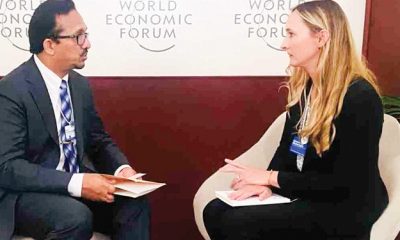
 Features4 days ago
Features4 days agoHandunnetti and Colonial Shackles of English in Sri Lanka
-
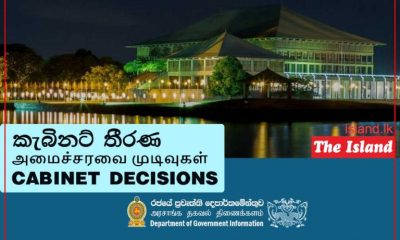
 Business3 days ago
Business3 days agoCabinet approves establishment of two 50 MW wind power stations in Mullikulum, Mannar region
-

 Business6 days ago
Business6 days agoSri Lanka betting its tourism future on cold, hard numbers
-

 News6 days ago
News6 days agoJetstar to launch Australia’s only low-cost direct flights to Sri Lanka, with fares from just $315^




